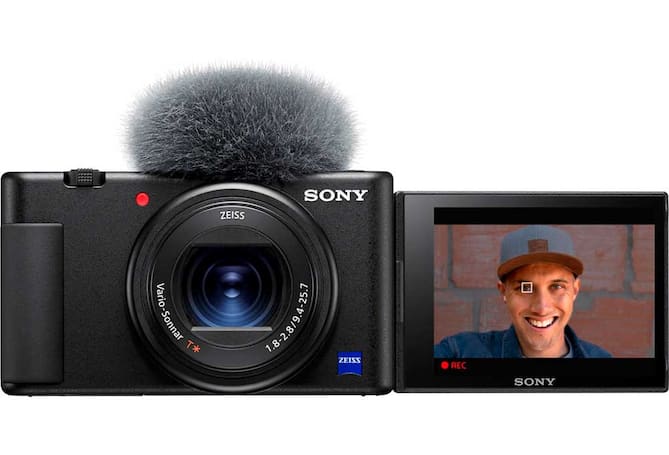How to Choose a Webcam for Streaming

Find the right setup for your needs.
What is a webcam? Along with digital single-lens reflex (DSLR) cameras, action cameras and camcorders, a webcam is a device commonly used for livestreaming. It’s a small video camera built into a computer or a separate device that attaches via a USB port. Additional uses are for taking part in video chats from your computer and for teleconferencing calls. Computer users looking for other ways to use their webcams often ask, what does a webcam do besides video chats and livestreaming? You can also use a webcam as a security camera, to take photos, and for motion tracking as an input device or video game controller.
For most streamers, webcams are convenient options because they’re easy to set up and use. Unlike DSLRs and action cameras, webcams don’t require tripods or additional mounting hardware for stabilization. Plus, they’re not bulky like camcorders. However, some webcams may not provide good quality videos for professional streaming setups. While the integrated webcam in your computer will do in a pinch, it’s likely a poor option for high-quality streaming.
External webcams offer better image and video quality. As livestreaming becomes more popular, webcam manufacturers are designing models specifically for that purpose. These offer broadcast-quality videos and features needed by professional content creators. If you’re looking for a webcam for streaming, here are the key features to consider.
Resolution and frame rate.
Resolution is often the main factor shoppers focus on when asking, what is the best webcam to buy? The resolution of a webcam will determine the quality of its video. Resolution describes image sharpness and clarity. Most standalone webcams offer high-resolution videos of at least 720 pixels. This is the minimum video resolution to look for in a webcam.
If you’re new to livestreaming, you may wonder whether a higher resolution is necessary. While a 720p webcam will do for livestreaming on a budget, you should look for models capable of 1080p or 4K resolution for professional-quality videos. Note that live broadcasts with higher resolutions require more bandwidth to stream, so you might want to invest in a dual-band router to avoid data delays.
While resolution describes clarity, frame rate determines the smoothness of a video. Measured in frames per second (fps), a high frame rate is essential for capturing fast motion during streams. Therefore, if you’re going to be moving a lot during your live broadcasts, find a model with the highest frame rate. The minimum frame rate to look for in a webcam is 30 fps. This fps is adequate if your livestreams mostly involve sitting and talking in front of a computer. Choose a webcam with 60 fps if you’re a streaming gamer, workout instructor, or anyone whose broadcasts involve a lot of movement.
Autofocus and low-light performance.
Autofocus is a camera and webcam feature that keeps the subject in focus even as lighting changes and when they move around in the shot. For livestreaming, look for a model with fast and precise autofocus capability.
A webcam’s low-light performance is important when shooting in dimly-lit areas. This feature is especially important if you're still struggling to find the right LED studio lights to keep your setups properly lit. A webcam with an impressive low-light capability will keep your video’s brightness level balanced even when broadcasting in a space that doesn’t have optimal lighting.
Field of view and adjustability.
A webcam’s field of view (FOV) is the span of the area it can capture. This usually ranges from 50 to 120 degrees. Field of view is a key feature to understand when researching webcams for streaming. The right FOV varies for different livestreaming setups. Choose a webcam with a small FOV if you only need to capture one person sitting in front of a computer. You need at least a 78-degree FOV to keep two people sitting in front of a computer in the same frame. Wider fields of view are best for livestreaming larger groups and spacious conference rooms.
The ability to adjust a webcam without needing to remove it from its mounted position is also an important feature to consider when choosing a webcam. A unit that’s easy to adjust makes it possible to reframe your shot and aim the camera at different spots while streaming. While you can use digital pan and zoom to reposition a webcam, the results are not always smooth; adjusting focus during a live broadcast with digital pan and zoom often degrades the video quality.
Microphone.
Lens type and quality.
Software control and support.
While comparing hardware features is important, you should also note software compatibility. Make sure the model you select is compatible with your computer’s operating system and the livestreaming software you use.
Most webcams produce recordings that are editable post-production with computer software to touch up brightness, contrast, color accuracy and white balance. Some also provide software control over digital pan, tilt and zoom functions. Therefore, an intuitive user interface should be a key consideration when comparing different options. If you require advanced streaming features, such as split-screen video streaming, make sure that the webcam you pick supports such features in your preferred streaming software.
Learning how to choose a webcam for livestreaming involves knowing the features to consider and understanding why they’re important. These key features include resolution, frame rate, autofocus, field of view, low-light performance, audio recording capabilities, lens type and software compatibility.